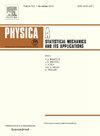Fractal-domain transformer based on learnable multifractal spectrum for chaotic systems classification
IF 2.8
3区 物理与天体物理
Q2 PHYSICS, MULTIDISCIPLINARY
Physica A: Statistical Mechanics and its Applications
Pub Date : 2025-01-15
DOI:10.1016/j.physa.2024.130276
引用次数: 0
Abstract
Conventional deep learning in the spatiotemporal-frequency domain frequently encounter challenges in terms of slow convergence rates and limited generalization, particularly for classification of chaotic systems. To address these limitations, this paper introduces a novel fractal-inspired deep network model, specifically, the Multifractal Spectrum Transformer (MFS-Transformer), grounded in learnable multifractal analysis. Initially, we put forward the conceptual framework of fractal learning, compared with traditional fractal signal processing methodologies and spatial-temporal domain learning paradigms. Subsequently, a Learnable Multifractal Spectrum (LMFS) derived from 3D spatial gridding, coupled with fractal-domain filtering, is proposed to construct the iterative learning process within the fractal domain. Further, we formulate the MFS-Transformer, an innovative architecture that integrates multi-channel embedding, LMFS, fractal-domain filtering, residual fusion mechanisms, a mixer module, and a classifier, tailored for chaotic system classification. Ultimately, we evaluate the efficacy of our model in classifying 3D chaotic systems under stringent conditions of short-term sequences and low Signal-to-Noise Ratio (SNR). Experimental outcomes underscore the substantial performance gains achieved by the MFS-Transformer, with classification accuracy enhancements of 13.34 % and 5.00 % over existing Convolutional Neural Networks (CNNs) and Recurrent Neural Networks (RNNs), respectively, under SNR= 0 dB and 32-sample sequences. These findings validate the superiority of the MFS-Transformer in addressing the complexities of chaotic system classification under complex scenarios. This research not only advances the frontier of fractal deep learning but also presents a novel perspective and methodology for tackling intricate spatiotemporal classification problems.
求助全文
约1分钟内获得全文
求助全文
来源期刊
CiteScore
7.20
自引率
9.10%
发文量
852
审稿时长
6.6 months
期刊介绍:
Physica A: Statistical Mechanics and its Applications
Recognized by the European Physical Society
Physica A publishes research in the field of statistical mechanics and its applications.
Statistical mechanics sets out to explain the behaviour of macroscopic systems by studying the statistical properties of their microscopic constituents.
Applications of the techniques of statistical mechanics are widespread, and include: applications to physical systems such as solids, liquids and gases; applications to chemical and biological systems (colloids, interfaces, complex fluids, polymers and biopolymers, cell physics); and other interdisciplinary applications to for instance biological, economical and sociological systems.

 求助内容:
求助内容: 应助结果提醒方式:
应助结果提醒方式:


